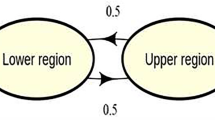Abstract
In this paper, a fractional-order predator–prey mathematical model has been developed considering Holling type II functional response. Here, we have investigated the interaction dynamics of prey, middle predator and top predator. We assume that the middle predator consumes only the prey, and the top predator consumes only the middle predator. Here, the logistic growth of prey has been considered. Then, different possible equilibrium points of our proposed system are determined. The stability of our proposed system is investigated around the equilibrium points. Then, some numerical simulations results are presented for better understanding the dynamics of our proposed model. It is found that the fractional-order derivative can improve the stability of our proposed system.









Similar content being viewed by others
References
Ahmed E, El-Sayed AMA, El-Saka Hala AA (2006) On some Routh–Hurwitz conditions for fractional order differential equations and their applications in Lorenz, Rössler, Chua and Chen systems. Phys Lett A 358:1–4
Ahmed E, El-Sayed AMA, El-Saka Hala AA (2007) Equilibrium points, stability and numerical solutions of fractional-order predator–prey and rabies models. J Math Anal Appl 325:542–553
Caputo M (1967) Linear models of dissipation whose Q is almost frequency independent-II. Geophys J R Astron Soc 13:529–539
Diethelm K (2010) The analysis of fractional differential equations. Springer, Berlin
Du M, Wang Z (2016) Correcting the initialization of models with fractional derivatives via history-dependent conditions. Acta Mech Sin 32:320–325
Du M, Wang Z, Hu H (2013) Measuring memory with the order of fractional derivative. Sci Rep 3:1–3
Garrappa R (2014) Solving fractional differential equations by MATLAB codes. Department of Mathematics University of Bari, Bari
Hastings A, Powell T (1991) Chaos in a three-species food chain. Ecology 72:896–903
Ionescu C, Lopes A, Copot D, Machado J, Bates J (2017) The role of fractional calculus in modelling biological phenomena: a review. Commun Nonlinear Sci Numer Simul 51:141–159
Javidi M, Nyamoradi N (2013) Dynamic analysis of a fractional-order prey–predator interaction with harvesting. J Appl Math Model 37:8946–8956
Lotka AJ (1925) Elements of physical biology. Williams and Wilkins, Baltimore
Magin RL (2016) Fractional calculus in bioengineering. Begell House, Redding
Mortoja Golam SK, Panja P, Mondal SK (2018) Dynamics of a predator–prey model with stage-structure on both species and anti-predator behavior. Inf Med Unlocked 10:50–57
Panja P, Mondal SK (2015) Stability analysis of coexistence of three species prey–predator model. Nonlinear Dyn 81:373–382
Panja P, Mondal SK, Jana DK (2017a) Effects of toxicants on Phytoplankton–Zooplankton–Fish dynamics and harvesting. Chaos Solitons Fractal 104:389–399
Panja P, Mondal SK, Chattopadyay J (2017b) Dynamical effects of anti-predator behaviour of adult prey in a predator–prey model with ratio-dependent functional response. Asian J Math Phys 1:19–32
Petras I (2011) Fractional-order nonlinear systems: modeling, analysis and simulation. Springer, London
Volterra V (1926) Variazioni e fluttuazioni del numero di individui in specie animali conviventi. Mem Acad Lincei 2:31–113
Author information
Authors and Affiliations
Corresponding author
Additional information
Publisher's Note
Springer Nature remains neutral with regard to jurisdictional claims in published maps and institutional affiliations.
Rights and permissions
About this article
Cite this article
Panja, P. Stability and dynamics of a fractional-order three-species predator–prey model. Theory Biosci. 138, 251–259 (2019). https://doi.org/10.1007/s12064-019-00291-5
Received:
Accepted:
Published:
Issue Date:
DOI: https://doi.org/10.1007/s12064-019-00291-5




